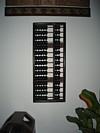|
Chinese abacus
Wooden frame with rings or beads as an aid to calculate. A Chinese
abacus consists of an upper deck
with two beads per bar and a lower deck with five beads per bar
(although modern versions often have only four). The beads of the
upper deck have a value of 5, those of the lower deck a value of
one. It has usually more than seven rods, the traditional one in the
picture below has 15. It is mostly used from right to left (although
some people use it in reverse) and the first column represents the
units, the second the tens, the third the hundreds, etc. To add a
value the beads are moved towards the horizontal beam at the centre
and the beads that are moved are counted. To start one has to add a
first the number, e.g. 54,323 on the
abacus
(fig.). This would be represented as 3 lower deck beads of the first rod
(value 3 x 1 = 3), 2 lower deck beads of the second rod (value 2 x
10 = 20), 3 lower deck beads of the third rod (value 3 x 100 = 300),
4 lower deck beads of the fourth rod (value 4 x 1,000 = 4,000) and 1
upper deck bead of the fifth rod (value = 5,000). To make an
addition of e.g. +2,826, one would move 1 bead from first rod of the
upper deck down (value = 5) and one bead from the lower deck up
(value = 1), this represents a total value of 6; then one would move
2 beads from the lower deck of the second rod up (value = 20); then
eight beads on the lower deck of the third rod (value = 800), but
there already were 3 beads standing, so one would therefore move one
bead of the next rod up (value = 1,000) and remove two beads
from the 3 already on the third rod (value = -200), thus creating
the total value needed (800); and finally two beads of the lower
deck of the fourth rod up (value = 2,000). To know the result of the
addition simply read the resultant bead positions. The
abacus can
also be used for other calculations such as subtractions,
multiplications and divisions, square roots and cube roots, but
these are a little more complicated and need skilled techniques.
Chinese abacuses are today still commonly used in traditional
Chinese pharmacies, gold shops (fig.)
and at the counters of Chinese shrines and temples. Occasionally,
also a circular version of the Chinese abacus can nowadays be found (fig.). In Chinese, known
as
suanpan.
回






|

